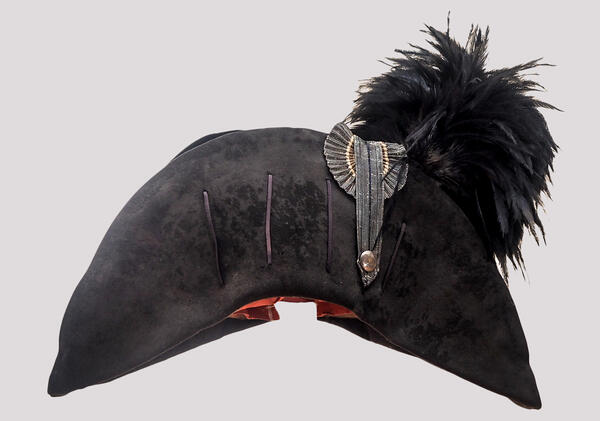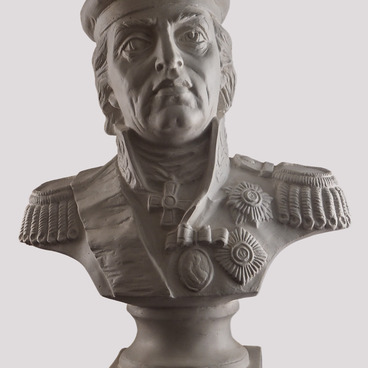This officer’s hat from the first third of the 19th century belonged to Colonel Ryad. Evgeny Andreevich Ryad — a representative of the Smolensk noble family, one of the five Ryad brothers, a participant of the Patriotic War of 1812.
Just before the Battle of Borodino, as a seventeen-year-old youngster, Ryad joined the ranks of the Russian army. As a cadet of the 7th Cavalry Company of the 3rd Reserve Artillery Brigade, he participated in the Battle of Borodino together with his four brothers. He was awarded the insignia of the Military Order, or, as they said then, the soldier’s George. Ryad took part in all the major battles of 1812, which made the glory of Russian army: at Tarutino, Maloyaroslavets, Krasny. He also participated in the overseas campaigns of the Russian army and was awarded the Orders of St. George of 4th degree and St. Anna of 4th degree, and was promoted to lieutenant.
In 1825, Ryad was promoted to captain, and in December of the same year he was sent from St. Petersburg to Taganrog to accompany the body of the Emperor Alexander I, who died there. Grand Duke Nikolai Pavlovich, the future emperor, wrote to Prince Volkonsky: “Ryad is coming to you, I decided to let him go to you”. Apparently, the sad events brought the future emperor closer to the hussar captain. In addition, Evgeny Andreevich Ryad spent December of 1825 in Taganrog and was not involved in the uprising on Senate Square, therefore, he could be trusted.
Evgeny Andreevich died on July 8, 1828 during the siege of the Shumla fortress by the Russian army. On that day, the colonel delivered the orders given by the emperor. During the battle, he was knocked off his horse by a cannonball. The colonel was only 33 years old, he did not have a family, and after the death of Yevgeny Andreyevich, his uniform and weapons were handed over to his younger brother Yakov Andreyevich. Yakov Ryad had already retired by that time and settled with his family in Smolensk. His daughter, Sofya Yakovlevna, married to Engelhardt, became the last representative of the Ryad family in Russia. After the death of Sophia Yakovlevna at the end of the 19th century, family relics of the Ryad family, including Yevgeny Andreyevich’s hat, were transferred to the museum.
Ryad’s hat — bicorne — a two-horned hat that replaced the more bulky and uncomfortable cocked hat at the end of the 18th century. The hat was a black woolen cap with wide brim. The fields were tightly attached to the crown in front and behind. Above, to the right of the center of the hat, was attached a round cockade of black silk. Over the cockade there was a narrow buttonhole with a gilded copper button. Above the cockade, a sultan of black cock feathers was inserted into the hat. These hats were worn by soldiers and officers. However, this headdress had no other advantages than its cheapness, and later officers began to wear it only for going out into the city, for balls and receptions.
Just before the Battle of Borodino, as a seventeen-year-old youngster, Ryad joined the ranks of the Russian army. As a cadet of the 7th Cavalry Company of the 3rd Reserve Artillery Brigade, he participated in the Battle of Borodino together with his four brothers. He was awarded the insignia of the Military Order, or, as they said then, the soldier’s George. Ryad took part in all the major battles of 1812, which made the glory of Russian army: at Tarutino, Maloyaroslavets, Krasny. He also participated in the overseas campaigns of the Russian army and was awarded the Orders of St. George of 4th degree and St. Anna of 4th degree, and was promoted to lieutenant.
In 1825, Ryad was promoted to captain, and in December of the same year he was sent from St. Petersburg to Taganrog to accompany the body of the Emperor Alexander I, who died there. Grand Duke Nikolai Pavlovich, the future emperor, wrote to Prince Volkonsky: “Ryad is coming to you, I decided to let him go to you”. Apparently, the sad events brought the future emperor closer to the hussar captain. In addition, Evgeny Andreevich Ryad spent December of 1825 in Taganrog and was not involved in the uprising on Senate Square, therefore, he could be trusted.
Evgeny Andreevich died on July 8, 1828 during the siege of the Shumla fortress by the Russian army. On that day, the colonel delivered the orders given by the emperor. During the battle, he was knocked off his horse by a cannonball. The colonel was only 33 years old, he did not have a family, and after the death of Yevgeny Andreyevich, his uniform and weapons were handed over to his younger brother Yakov Andreyevich. Yakov Ryad had already retired by that time and settled with his family in Smolensk. His daughter, Sofya Yakovlevna, married to Engelhardt, became the last representative of the Ryad family in Russia. After the death of Sophia Yakovlevna at the end of the 19th century, family relics of the Ryad family, including Yevgeny Andreyevich’s hat, were transferred to the museum.
Ryad’s hat — bicorne — a two-horned hat that replaced the more bulky and uncomfortable cocked hat at the end of the 18th century. The hat was a black woolen cap with wide brim. The fields were tightly attached to the crown in front and behind. Above, to the right of the center of the hat, was attached a round cockade of black silk. Over the cockade there was a narrow buttonhole with a gilded copper button. Above the cockade, a sultan of black cock feathers was inserted into the hat. These hats were worn by soldiers and officers. However, this headdress had no other advantages than its cheapness, and later officers began to wear it only for going out into the city, for balls and receptions.



